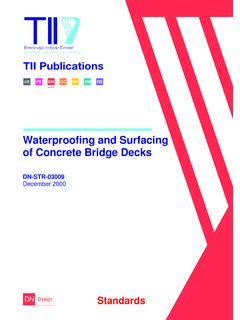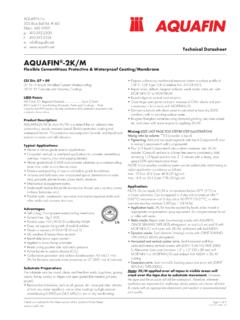Transcription of INSTALLATION OF CERAMIC TILE IN SWIMMING POOLS …
1 INSTALLATION of CERAMIC Tile in SWIMMING POOLS , AIA/CES Seminar Outline 2000 Richard P. Goldberg AIA, CSIPROCONIntl1 INSTALLATION OF CERAMIC TILE IN SWIMMING POOLSA merican Institute of ArchitectsContinuing Education SeminarbyRichard P. Goldberg , AIA, CSIA rchitectProfessional Consultants InternationalDESIGN CONSIDERATIONSI. Primary types of swimmingpool structuresA. Cast-in-place reinforced concrete1. Definition-concrete placed or pumped on-site over steel reinforcing; vertical wallscontained by formwork on both2. Applications-typically large commercial POOLS ,elevated POOLS , or on-grade POOLS inareas with poor subsoil Design considerations for CERAMIC tilea. forming & movement joints( general)-vertically formed walls and floors must becast monolithically in order to avoid crackingand the need for movementjoints (internal form must be suspended on external form);form carriers anchored aboveconcrete recommended to avoid form or dissipating (oxidizing) formreleaseagents are recommended toavoid contamination with water repellent concrete more likely to crack from drying shrinkage and other factors ifleft to dry > 3 months after placement; damp cure for 7-14 days ; requires careful designconsideration ofmovement joints; joints in shell must continue to ceramictile surface to prevent random cracks from developing and transmitting to CERAMIC tilesurface.
2 Increased steel reinforcing will increase resistance toshrinkage cracks (isolation membranes not recommended unless full coverage of poolshell with waterproof anti-fracture or crack suppression membraneb. recommended to increase concrete coverage over steel reinforcing by 1/4 in (6 mm)to compensate for any bulk surface removal required to prepare surface (see below).B. Gunite or shotcrete reinforced concrete1. Definition-mortar or concrete projected through a hose and pneumaticallyprojected at high velocity onto a reinforced surface, usually formed on one side Applications-below grade, small residential or light commercial POOLS withgood subsoil conditions; may also be used over Design considerations for CERAMIC tilea. eliminatesmovement joints in pool shell-typically gunite POOLS donot require movement joints in the shell because the tendency for crackingfrom thermal movement is reduced.)
3 However, movement joints in tilesurface required to accommodate thermal and moisture movement of tile of poolemptied for maintenanceGunite walls thinner-absence of formwork means less heat fromhydration resulting in less thermal induced plastic shrinkage is typically reinforced with high tensile steel fabricwhich provides agreater resistance to normal reinforcing size and frequency typical of cast-in-placereinforced concrete .Quality gunite typically has a very low water to cement ratio cement, thus lessInstallation of CERAMIC Tile in SWIMMING POOLS , AIA/CES Seminar Outline 2000 Richard P. Goldberg AIA, CSIPROCONIntl2susceptible to drying shrinkage strength of quality gunite8,000 psi (55 Mpa) with equivalentincrease in tensile strength over typical cast-in-place reinforced concrete 3,000 psi(20 Mpa).
4 B. configuration problem for CERAMIC tile-structural design of gunite poolstypically requires a radiused cove at floor-wall intersection, making larger ceramictiles difficult to installII. Movement / Expansion JointsA. General-movement joints are necessary in cast-in-place concrete pool shells andtypically not required in most small gunite concrete pool shells (see above); the structure of thepool requires careful design and construction sequencing in order to minimize the number ofmovement joints of movement joints are one of the leading causes of failure in CERAMIC tiled POOLS ,especially when POOLS are allowed to dry for long periods (> 3 months) after initial placement ofconcrete,when tileis installed within one month of concrete pour , or when pool is emptied formaintenance and allowed to dry out.
5 Movement joints are often omitted because of difficultieswith waterproofing/sealantinstallation construction / cold joint-walls / floors typically are cast monolithically butlarge POOLS require multiple pours ; concrete will crack at these weak intersections andrequiremovement joint with integral waterstops2. control joint-prevents random cracking by controlling drying shrinkage in straightline; typical eliminated by use of additional reinforcing to control shrinkage and keepingconcrete from drying out before expansion joint-accommodates thermal and moisture movementin m (164 ft) length pool expands 10 mm (.4 in) on average after filling andrequires aggregate joint width 3-4 times the anticipated movement or 30-40 mm ( ) sealing movement joints-whether a pool needs to be completely waterproof(prevents any leaks ), or watertight (monolithic structure which contains waterwith minimal absorption and leakage), movement joints must be designed to preventrapid loss of primary protection-sealantsprovide primary closure of joints and can notprovide 100 % effectiveness as a barrier to water leakage.
6 Sealants must besuitable for water submersion and be installed with proper backer rods and toolingby secondary protection-waterstopsare flexible plastic or butyl rubber devices whichare integrally cast in, or placed below movement joints in POOLS to provide a flexible yetmonolithic, watertight connection across movement joints. Waterstops are criticalsecondary protection even when waterproof membranes are PROCEDURESI. Surface and Cleaning-Concrete pool shells are rarely smooth , free ofcontamination and defects, and level enough for direct bonding of waterproof membranesor CERAMIC tiles. Improper preparation and cleaning are a primary cause of failure ofwaterproof membranes and leveling mortars (renders and screeds) in POOLS . Cast-in-placeconcrete wallspresent specific defects such as form release or curing agents, and surfacedefects such as honeycombing and laitance.
7 Floors are subject to surface defects such asdusting,crazing,and laitance from improper finishing, as well assignificant ground inconstruction of CERAMIC Tile in SWIMMING POOLS , AIA/CES Seminar Outline 2000 Richard P. Goldberg AIA, CSIPROCONIntl31. Typical Methodsa. High Pressure Water Blasting-5,000-8,000 psi (34-54 Mpa) to removesevere contamination by removal of top 1/8-1/4 in (3-5 mm) and to exposeaggregate for improved mechanical bond of standard Portland cement leveling mortars(screed and renders).b. High Pressure Water Cleaning-1,000 psi ( Mpa) to clean surface dirtand contamination or weakened surface layer (laitance) without aggregateexposure; use in conjunction with detergents and degreasers to remove dirt or lightcoatings of oil or other Shot blasting-effective for floors and walls (with hand held equipment);removes and collects debris in one step from top layer 1/16-1/4 in (1-6 mm) withfine to coarse steel pellets.
8 Use to remove existing paint coatings or concretesurface defects such as Grinding-variety of mechanical scarifying methods available, must insure finalcleaning of residue with high pressure water or aire. Grit Blasting-includes traditional sand blasting, which is effective but intrusive andhazardous; or new methods incorporating water soluble, mechanically refined sodiumcarbonate grit mediaf. Acid cleaning-this method is not recommended if other methods are availablebecause improper dilutions and improper applicationmethods (failure to saturate surfaces with water) and improper neutralizing/rinsing ofresidue can deteriorate concrete surface and or cause post INSTALLATION efflorescencefrom residual soluble chlorides. Residual chloride can also inhibit bond,accelerate set of cement based mortars and adhesives, or causechloride iondeterioration of steel Low pressure water/scrubbing-ordinary garden hose washing with bristlebrush scrubbing is satisfactory if concrete has no surface defects or oily, organiccontamination.
9 Any cleaning agents must be completely Wall Patching, Plastering or Rendering-necessary if concrete can not be designedand finished accurately to meet levelness (flatness) tolerance for direct application of ceramictile using thin set method 1/8 inch in 10 ft (3 mm in 3 m) or if plumbness (vertical) deviation iswithin 1 inch (25 mm).1. Latex Portland cement leveling mortar (render)-1:3 pc: masonry sandwith latex additive recommended for best adhesion and performance under thermal andmoisture movement differential and exposure to effects of water treatment; should bemixed to a plastic consistency and applied no greater than to 1/2 in (12 mm) thickper application; carry underlying movement joints to Portland cement mortars-same requirements as above, except surfacepreparation must expose aggregate of concrete, or spatter dash coat must beapplied to increase mechanical key for improved bond typically provided by Floor Leveling or Screeding-necessary if concrete can not be designedand finished accurately to meet levelness tolerance for direct application of CERAMIC tileusing thin set method 1/8 inch in 10 ft (3 mm in 3 m).
10 Portland cement mortar-same type of mortar as above,appliedfrom 1-2 1/2 in (25-65 mm) mixed to a semi-dry consistency and placed over alatex/cement slurry bond coat, leveled between screeding boards and WaterproofingA. Methods of waterproofing SWIMMING pools1. External or "sandwich" slab waterproof membranes-sheet or fluidapplied membrane installed between two layers of concrete or between grade andconcrete shell; this method is costly and typically used when external or negativehydrostatic water pressure is present to protect CERAMIC tiles from delaminationInstallation of CERAMIC Tile in SWIMMING POOLS , AIA/CES Seminar Outline 2000 Richard P. Goldberg AIA, CSIPROCONIntl4when pool is emptied, or withmembranes that do not allow direct adhesionof CERAMIC Direct bond waterproof membranes-sheet or fluid applied membranedesigned for direct bond of CERAMIC tile using adhesive mortars.







